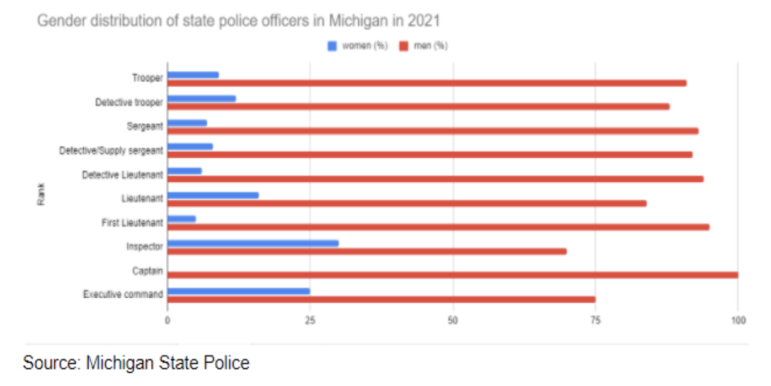By ZAIRA MAGOMEDOVA
Capital News Service
LANSING – Only 9% of Michigan State Police officers are women.
That’s better than 2%-8% in most other state police agencies, but worse than 13% in Vermont and North Carolina, a new Pew Research Center study finds.
However, the State Police plans to improve the situation by increasing the percentage of women in its applicant pool up to 20% by the end of next year.
In Michigan, the numbers improve a little in the higher ranks. Women make up 30% of inspectors (three of 10) and 25% of executive officers (two of eight). But they make up only 5% of first lieutenants and 6% of detective lieutenants.
Of the department’s 995 state troopers, just 91 are women.
When it comes to recruiting, the situation gets slightly better, with women making up 11% of the State Police Trooper Recruit School graduates, six out of 55 troopers being female.
In 2020 women made up 16% of the graduates, 9 out of 55 troopers. This is the highest percentage of female graduates of the school in five years, according to MSP data on the school demographics.
Local police face similar challenges.
There could be several reasons behind the lack of women in law enforcement, said Midland Police Chief Nicole Ford. “Unfortunately, the job is very challenging because of the 24/7 operation. So, I think, we lose a lot of people that way: You’re gonna be working on weekends and holidays, you’re gonna be missing birthdays and that kind of stuff.”
Sexism is another reason the job can be challenging, Ford said.
“Now that I’m a chief, the situation is different, but I’ve had very inappropriate things said to me by my male coworkers, and even women struggled with the idea of female police chiefs,” Ford said.
“Sometimes, they told me that they didn’t think females should be police officers. There are still a lot of people that don’t believe women belong to law enforcement.”
The presence of women in law enforcement is beneficial, Ford said.
“Women are excellent communicators. They try to communicate to defuse the situation before going “hands-on.”
“Oftentimes, when you have a female officer that responds to a scene, and a male suspect is involved, there is no immediate power struggle, she said. “A lot of times, the mere presence of a female police officer can help de-escalate a scene.”

“There are 13 women among 385 members of our association,” said Robert Stevenson,the executive director of the Michigan Association of Police Chiefs. “But we certainly don’t have any barriers to females joining us.
“As a matter of fact, they are highly sought after by the State Police Department because the department wants to be diverse and represent their community,” Stevenson said.
“Reducing barriers to employment” to increase the trooper minority applicant pool and female applicant pool is one of the objectives stated in the Strategic Direction, a booklet by State Police that points out main goals of the department for 2020-22.
However, there is a catch: Michigan law prohibits the state from the use of affirmative action, that is steps to increase employment or enrollment of historically underprivileged groups. Michigan is one of nine states in the U.S. that ban affirmative action.
“We do have various programs and training courses, but they are created for everyone, not for hiring women specifically,” Stevenson said. “We have to be very careful to give any preferences to one group over another. The court of the state has a rule against any type of affirmative action.”
By the end of 2022 the State Police plans to increase female applicants to 20% of its pool, said Inspector Lisa Rish.
“We do not plan to reach that goal by lowering our standards. Our goal is to reach out to as many people as possible so that women who are great for this job but do not have enough information about it, and therefore do not consider it as something possible for them, could have an opportunity to apply,” she said.
Role models play an important role in attracting more female applicants, Rish said.
“We meet a lot of people, participate and organize job fairs, making sure that there are women among recruiters. The recruiters share their experience at the police, so everybody can see that being a police officer is not something impossible for a woman.”